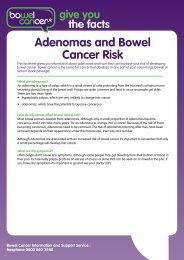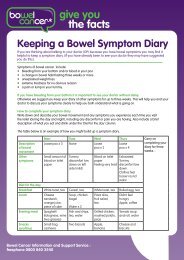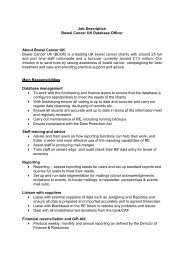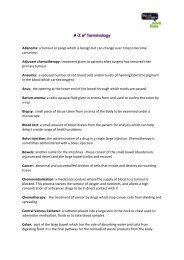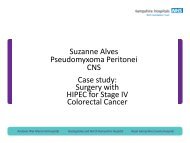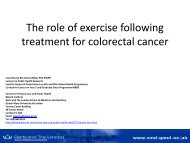Management of Constipation - Bowel Cancer UK
Management of Constipation - Bowel Cancer UK
Management of Constipation - Bowel Cancer UK
Create successful ePaper yourself
Turn your PDF publications into a flip-book with our unique Google optimized e-Paper software.
<strong>Constipation</strong>: new options for acommon problemAnton EmmanuelMarch 2013National Hospitalfor Neurology& Neurosurgery
<strong>Constipation</strong> is a common problem8-25% community prevalenceFemale preponderance (2 to 8 times)>500,000 physician visits/year£60m /year on OTC laxatives1.2m laxative prescriptions / year
Auto-intoxication<strong>Constipation</strong>: the “disease <strong>of</strong> diseases”In his lifetime, accepted as nonsenseZero evidence to support in 100 years(Ernst, J Clin Gastro 1997)(Muller-Lissner & Kamm, Gut2007)Arbuthnot-Lane1856-1943
<strong>Bowel</strong> opening is complexChronic constipationGot to be fullHave to know that it is fullGot to squeeze itGot to take the lid <strong>of</strong>f and putit back on
Effect <strong>of</strong> dietary fibre & exerciseNurses Health Study: 62,036 women aged 36-61 years3327 (5.4%) constipated ( 7.7gm/dayNot a trialPossible confoundingby co-morbiditiesDukas et al Am J Gastroenterol 2003;98(8):1790-6
Benefit and limitations <strong>of</strong> exerciseSeveral other studies link exercise with reduced riskCommunity survey <strong>of</strong> 1,699 Japanese>4h /day walking reduces risk OR 0.46(0.2-1.0)Nakaji et al Eur J Nutr 2002;41(6):244-8One RCT <strong>of</strong> exercise in IBS-C56 IBS randomised to usual care or 12 weeks exercise programmeRecruitment low (18%)Primary endpoint : QOL showed no changeSignificant improvement in constipationDaley et al Int J Sports Med 2008;29(9):778-82
Role <strong>of</strong> fluid intake?7% develop constipation in 3 months following admission to nursinghomeRisk factors: race, decreased fluid intake, pneumonia and Parkinson’sdiseaseRobson et al Dis Colon Rectum 2000;43(7):940-3Severe water restriction reduces stool weight• RCT in healthy volunteers reducing fluid intake from 2500ml to
Effect <strong>of</strong> fibreChemical effect manifests physicallyPhysical effect maximised outFermentabilityFermentationBiliary salts and fattrapped within thematrixEdges <strong>of</strong> particlesStoolbulkingGasSCFAStimulation <strong>of</strong>propulsion andsecretionExcitation <strong>of</strong>sub-mucosalmechanoreceptorsWalldistensionColonic contractileactivityDecrease <strong>of</strong> segmentationIncrease <strong>of</strong> propulsionAcceleration <strong>of</strong> transit time
Bulking agentsDecreased total gut transit time after 1 month <strong>of</strong>psyllium in patients with dyssynergic defaecation 1P
Stool s<strong>of</strong>tenersDocusate appears less effective than psyllium in improving bowel movementsand stool output after 2 weeks in patients with normal transit constipation 4P
Osmotic agents: LactuloseSlow transit success (needing ≤1 additionallaxative during 3-week treatment period) withlactulose 1Reduced faecal impaction after 2 months<strong>of</strong> lactulose 1P
Osmotic agents: polyethylene glycolHigher stool frequency with PEG vslactulose after 1 month: elderly 1P
StimulantsMore frequent bowel movements with bisacodylvs placebo in patients with “occasional misseddays” 3 *More frequent bowel movements with sennoside plusbulk laxative vs lactulose in elderly patients (n=30) 4P
Are current laxative options effective?16–40% <strong>of</strong> those with constipation use laxativesSymptoms persist despite laxative use10080Patients with ongoing constipation symptoms (%)Use laxativeDo not use laxative6040200 US <strong>UK</strong> FR GE IT BR SKCountryApproximately 2000 adults each from: United States, US; United Kingdom, <strong>UK</strong>;France, FR; Germany, GE; Italy, IT; Brazil, BR; South Korea, SKWald et al. Aliment Pharmacol Ther 2008;28:917
Patients requirements <strong>of</strong> constipation treatments?Speed <strong>of</strong> effect• Ideally within 1 hour <strong>of</strong> taking pill• This gives patient predictabilityDuration <strong>of</strong> action• Want the effectiveness to last for a longer period <strong>of</strong> timeUsage frequency & Type• Desire a product that can be taken on a “as needed” acute basis ratherthan ones that need to be taken chronically (e.g. once daily dosing)• Prefer OTC products to Rx therapies• Prefer pill to other formulationsSide effect pr<strong>of</strong>ileGentleness <strong>of</strong> treatment• Besides fast onset, the absence <strong>of</strong> side effects is <strong>of</strong> major importance.Compatibility is absolutely key and it is very important that side effectsdon’t occur outside the stomach region (e.g. headaches or dizziness)• There is a strong desire for gentle, but effective treatments, (i.e.homeopathic or herbal products). This is based on negative feelingstowards chemicals and the fear to damage the body by chemical drugsInformation and education• There is a high and unmet need for information and education17
Laxatives for chronic constipation:Luminal mechanism <strong>of</strong> actionGUT WALLWaterbindingin stoolStools<strong>of</strong>tening &lowers surfacetension <strong>of</strong> stoolSalts, Sugars and Osmotic agentsFibre and Bulking agentsDocusate and Stool s<strong>of</strong>tenersPeristalsisSenna and Stimulant agentsTack & Müller-Lissner. Clin Gastroenterol Hepatol 2009;7:502
Chronic constipation:Symptoms in self-reported constipation● 1149 participants● 27.2% self-reported constipation within the past 3 months● 16.7% and 14.9% constipation according to Rome I and IISelf-reported responders (%)100806040200StrainingHard/lumpystoolsIncompleteemptyingStool cannot bepassedAbdominalfullness/bloating
To be asbrave as 21
Dispel mythsIs chronic constipation best treated byincreasing the intake <strong>of</strong> dietary fibre?Will increasing fluid intake improve chronicconstipation?Is increasing physical activity beneficial foralleviating chronic constipation?Does a long residence <strong>of</strong> stools in the colonlead to autointoxication?Can the long-term use <strong>of</strong> laxatives causeneuronal or muscular damage to the colon?
Dispel mythsIs chronic constipation best treated byincreasing the intake <strong>of</strong> dietary fibre?Will increasing fluid intake improve chronicconstipation?Is increasing physical activity beneficial foralleviating chronic constipation?Does a long residence <strong>of</strong> stools in the colonlead to autointoxication?Can the long-term use <strong>of</strong> laxatives causeneuronal or muscular damage to the colon?NotalwaysNotalwaysUnlikelyNoUnlikely
MythsDoes long-term use <strong>of</strong> laxatives increasethe risk <strong>of</strong> colorectal cancer?Can laxatives lead to tolerance,dependence and addiction?Can laxatives be used in combination witheach other?Is it abnormal to have a stool that is toohard or too loose?Is it abnormal to have less than one bowelmovement per day?
MythsDoes long-term use <strong>of</strong> laxatives increasethe risk <strong>of</strong> colorectal cancer?Can laxatives lead to tolerance,dependence and addiction?Can laxatives be used in combination witheach other?Is it abnormal to have a stool that is toohard or too loose?Is it abnormal to have less than one bowelmovement per day?HighlyunlikelyRarelyYesNotnecessarilyNotnecessarily
Emerging treatments“Prokinetics”Gut flora in colon lumen5-HT 4 receptorBasolateral membraneTight junctionApical membraneLumenEpithelial cell layerChloridechannelMucosaCl –Enteric nervous systemMuscularis mucosaSubmucosaCircular muscle layerMyenteric nerve plexusGuanylatecyclasereceptorLongitudinal muscle layer+Cl –Prucalopride▼Alvimopan*Lubiprostone*MethylnaltrexoneLinaclotide*Probioticsμ-opioid receptor* Not licensed within <strong>UK</strong> (February 2012)
Probiotics in chronic constipation1 pot b.d.Bifidobacterium lactis1.25 × 10 10 cfuStreptococcus thermophilus1.2 × 10 9 cfuLactobacillus bulgaricus1.2 × 10 9 cfuAgrawal et al Aliment Pharmacol Ther 2008
Emerging treatments: Medical probioticsRCT details•Lactobacillus caseiShirota vs placebo 1•70 adults; 4-weeks•Lactobacillus caseirhamnosus vs MgOvs placebo 2•45 children; 4-weeks•Lactobacillus reuterivs placebo 3•44 infants; 12-monthsKey findings•Probiotic improved self-reported severity <strong>of</strong> constipation and stoolconsistency from Week 2 (P
Prokinetics vs. laxatives:laxativeprokineticlaxatives: act in the gut lumenprokinetics: act in the gut wallafter systemic absorption
Colonic 5-HT receptorsExtrinsicafferentExcitatorymotorneuron AChSPSensoryneuron+ + + – – –NOVIPInhibitorymotorneuronACh = acetylcholine; SP = substance P;NO = nitric oxide; VIP = vasoactive intestinal peptide5-HT5-HT 4 receptor5-HT3 receptor
% over 12 weeksEfficacy in chronic constipation:≥3 SCBM/week (primary endpoint)3530252023.6***24.7***19.5**23.6***23.9**23.5**30.9***28.4***151011.39.612.1 12.050Camilleri 11(n=1924)Tack 2(n=713) (91% F)Quigley 3(n=641) (87% F)Camilleri 4(n=620) (88% F)SCBM = spontaneous complete bowel movementsPlacebo Prucalopride 2 mg Prucalopride 4 mg**p≤0.01 vs. placebo***p≤0.001 vs. placebo1Camilleri et al. Gastroenterology 2008;134:A548. 2 Tack et al. Gut 2009;58:3573Quigley et al. Aliment Pharmacol Ther 2008;29:315. 4 Camilleri et al. N Engl J Med 2008;358:2344The 4 mg dose has not been licensed since no incremental benefit wasdemonstrated versus the 2 mg dose
PrucaloprideEffect on symptoms associated with chronic constipation 1PRPRUI1. Kerstens et al.Gut 2010;59(Suppl III):A360
Oral MethylNaltrexone*not licensed in <strong>UK</strong>/EUEvidence primarily inopioid constipationChappell et al. NEJM 2008;Diego L et al. Expert Rev Gastroenterol Hepatol 2009
LinaclotideLembo et al NEJM 2011
eforeSphincterRectumSphincterafterRectum
Optimal timing for attempted defaecationNarducci et al Gut 1987;28(1):17-25
Importance <strong>of</strong> synchronising defaecatory effort withcolonic mass movementsDinning et al Gastroenterology 2004;127(1):49-56
Is bi<strong>of</strong>eedback better than stimulantlaxatives?% improvementbi<strong>of</strong>eedbackbisacodylRCT BF vs bisacodyl(Rao et al AJG 2007)need to strain51 patients, all with dyssinergia1. Rao et al. Clin Gastroenterol Hepatol. 2007;5:331-8
75Bi<strong>of</strong>eedback: Long Term BenefitsPre bi<strong>of</strong>eedbackPost bi<strong>of</strong>eedbackSymptom Scores50250
75Bi<strong>of</strong>eedback: Long Term BenefitsPre BFPost BFfollow-up (median 4yrs)Symptom Scores50250
Transanal irrigationTechnique• Introduction <strong>of</strong> fluid (e.g.,lukewarm water) into the colonvia the anus, to evacuate faecesfrom the bowel 1Indications• Patients with constipation(and/or faecal incontinence)caused by neurogenic boweldysfunction due to spinal cordinjury (SCI) 1,2Contraindications• Acute active inflammatory boweldisease, and obstructing rectalor colonic mass 3411. Coggrave. Nurs Times 2007;103(26):472. Christensen et al. Gastroenterology. 2006;131(3):738-473. Coggrave. Nursing Times 2007;103(47):44-6[Image developed for ACT programme]
Transanal irrigationEvidence• Clinical trial data show success <strong>of</strong>transanal irrigation in 65% SCIpatients with constipation 1-3– Improved symptoms andquality <strong>of</strong> life vs conservativemanagement 1,2Potential adverse effects• Estimated risk <strong>of</strong> bowel perforationin patients using transanalirrigation is ≤0.002% (1 in ~80,000irrigations) 4Outcomes <strong>of</strong> transanal irrigation in patients(n=79) with chronic idiopathic constipationafter mean follow-up <strong>of</strong> 21 months 3Idiopathicconstipation*Success, n(%)Slow transit (n=43) 14 (32.6)Obstructeddefaecation,but normal transit(n=30)13 (43.3)Undetermined (n=6) 0 (0)*According to the Rome criteria1. Christensen et al. Gastroenterology. 2006;131(3):738-472. Christensen et al. J Spinal Cord Med. 2008;31:560–73. Christensen et al. Dis Colon Rectum. 2009;52(2)286-924. Emmanuel, Spinal Cord 2010:48:664-73




